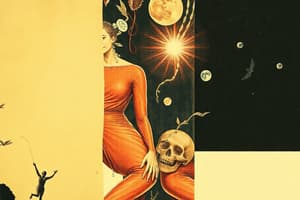Podcast
Questions and Answers
During the light-dependent reactions of photosynthesis, what is the immediate fate of electrons that are excited by light energy in chlorophyll?
During the light-dependent reactions of photosynthesis, what is the immediate fate of electrons that are excited by light energy in chlorophyll?
- They are stored within the chlorophyll molecule for later use in the Calvin cycle.
- They immediately combine with hydroxyl ions to form water.
- They are directly used to reduce carbon dioxide into glucose.
- They are transferred to electron carriers to generate ATP and reducing power. (correct)
How do the light-dependent and light-independent reactions (Calvin cycle) cooperate in the process of photosynthesis?
How do the light-dependent and light-independent reactions (Calvin cycle) cooperate in the process of photosynthesis?
- The light-dependent reactions generate ATP and NADPH, which are then used by the Calvin cycle to fix carbon dioxide into glucose. (correct)
- The Calvin cycle produces oxygen, which is then used by the light-dependent reactions to split water.
- The Calvin cycle regenerates chlorophyll, which is then used by the light-dependent reactions to capture light energy.
- The light-dependent reactions produce glucose, which is then used to power the Calvin cycle.
If a plant is exposed to a toxin that inhibits the function of photosynthetic enzymes present in the stroma, which process would be directly affected?
If a plant is exposed to a toxin that inhibits the function of photosynthetic enzymes present in the stroma, which process would be directly affected?
- The fixation of carbon dioxide and its reduction into glucose. (correct)
- The splitting of water molecules during the light-dependent reactions.
- The release of oxygen into the atmosphere.
- The regeneration of chlorophyll molecules in the grana.
In photosynthesis, what is the role of water molecules ($H_2O$) during the light-dependent reactions?
In photosynthesis, what is the role of water molecules ($H_2O$) during the light-dependent reactions?
Why is the dark reaction also referred to as the Calvin cycle?
Why is the dark reaction also referred to as the Calvin cycle?
Flashcards
Light Reaction
Light Reaction
The initial phase of photosynthesis where light energy is converted into chemical energy (ATP and NADPH).
Grana
Grana
Stacks of thylakoids within the chloroplasts where the light reaction occurs.
Dark Reaction
Dark Reaction
The enzyme-catalyzed reactions that convert carbon dioxide and hydrogen into glucose.
Stroma
Stroma
Signup and view all the flashcards
Calvin Cycle
Calvin Cycle
Signup and view all the flashcards
Study Notes
- Light reaction occurs in the grana
- Chlorophyll in the grana captures light energy
- Light energy splits water molecules into hydrogen ions and hydroxide ions
- Light energy excites chlorophyll electrons
- Excited electrons leave chlorophyll molecules
- Energy from excited electrons forms adenosine triphosphate (ATP)
- Hydrogen ions combine with electrons to form hydrogen atoms
- Hydrogen atoms provide reducing power for the dark reaction
- Hydroxyl ions lose electrons to form hydroxyl groups
- Hydroxyl groups combine to form water and gaseous oxygen
- Oxygen is released into the atmosphere for cellular respiration
Dark Reaction
- Occurs in the stroma
- Also known as the Calvin cycle
- It does not require light energy
- Hydrogen atoms from the light reaction are used
- Hydrogen atoms fix carbon dioxide
- Carbon dioxide is reduced into glucose and water through a series of reactions
- Reactions are catalyzed by photosynthetic enzymes
- Glucose monomers condense to form starch
- Starch is temporarily stored as starch grains in the chloroplast
Studying That Suits You
Use AI to generate personalized quizzes and flashcards to suit your learning preferences.





